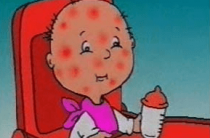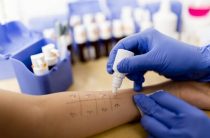Allergy is one of the most common diseases of our time, from which every fifth person suffers. The very word "disease" does not reflect the essence of allergy. In fact, this is a set of disorders that are characterized by the occurrence of allergic reactions upon contact with the causative agent of allergies. The true nature of this violation has not been established, there is a suspicion of a number of factors (influence of industrial waste, unnatural nutrition, increased background radiation, etc.)
A clear relationship cannot be traced, since residents of large cities are at risk, experiencing the influence of the totality of harmful factors, so it is often impossible to distinguish between them. The hereditary factor plays an important role in the development of allergic symptoms. Thus, children who are born to mothers with allergies have a 40% greater predisposition to develop allergic diseases. This probability is doubled if both parents of a child suffer from allergies. The presence of allergic diseases among relatives also contributes, although less than with direct transmission from parents. In general, the further the degree of relationship, the less chance of hereditary transmission during pregnancy.
Allergic symptoms in young children deserve special attention. In this case, we are not talking about persistent allergies, but about cases of sensitivity of the baby's body to certain factors. In general, allergies in children develop at the time of a sharp transition from breastfeeding to natural food. In pediatric practice, an optimal scheme for the transition from breast milk to natural nutrition has been developed. Nevertheless, the baby's body is able to react sharply to the intake of any products, even in small quantities. Basically, the child outgrows this and the allergies are a thing of the past.
Allergy medications are one of the most sought-after medicines in the modern world. Every day there is a search for new drugs, as well as data collection on current methods of treatment of already used drugs.
Allergy Prevention Means
The first thing an allergy sufferer needs to do is to take measures that are aimed at avoiding contact of the body with the allergen. Without a sensitive component, the development of an allergic reaction is simply impossible. If you suspect that you have an allergy, then you need to urgently consult a doctor who will prescribe diagnostic measures for you to track the body's reaction to the most common allergens. The circle of alleged allergens noticeably narrows after the doctor asks about the patient's lifestyle, as well as his observations about his own health.
- In general, the means of prevention for this disease include:
- Determine the cause of the allergy. In this context, we mean a substance that provokes allergic reactions. Avoid it by all means.
- If you have a seasonal allergy (allergy to flowering, mosquito bites, poplar fluff, etc.), then it is necessary to carry out specific immunotherapy during periods of remission;
- For food allergies, be careful about finding out the composition of multicomponent products.
- At a party or in catering establishments, do not hesitate to ask questions about the ingredients that make up the dish;
- During an exacerbation of allergic manifestations, adhere to a hypoallergenic diet. It excludes products that, due to their composition, can have a potentiating effect on the development of allergy symptoms.
- If you suffer from asthmatic manifestations, then you need to install a special device in the room that maintains optimal air humidity. Consult with your doctor about setting the optimal parameters for his work!;
- If you suffer from respiratory allergies (to components that are carried with air), you need to wet clean the room as often as possible; install special filters for indoor air; refrain from walking in dry and windy weather (if the allergen is common at this time); use a special respirator or a bandage made of several layers of gauze; install special nets on windows, with a minimum diameter of gaps;
- If you are prone to food allergies, then you need to be careful about trying new foods;
- Engage in moderate physical activity - this stabilizes the immune system. Actual measure, with allergies of a very different nature. For the same purpose, dousing with cold water can be additionally used, provided that the hardening procedure is followed correctly;
- To avoid sun allergies, remember that some factors (food, pollen, medicines, chlorinated water) can increase skin sensitivity to UV radiation;
- Eat enough vitamins and minerals - these are substances that are necessary for the normal functioning of the immune system;
- Use clothes made from natural fabrics;
- For skin manifestations, it is better to avoid contact with animal hair and feathers. Even if you are not allergic to these components, they also have a provoking effect on the skin;
- For the same purpose, it is not recommended to use numerous means of cosmetics, perfumes and household chemicals. In this matter, it is better to maintain a reasonable measure, since these substances provoke additional skin irritation;
- If you are allergic to insect stings, avoid places where they sting. Allergy to insect venom is often prone to severe course with the immediate development of symptoms of anaphylaxis, be careful.
Means for preventing allergies in a child
Children, due to the fact that their body is at the stage of formation of the immune system, are most often susceptible to various kinds of allergic reactions. This is due to the fact that the body is trying to protect the child to the maximum from the dangers of the outside world, which he, unlike an adult, endures much worse. As a result, the child's body is much more sensitive to the usual things for an adult.
There is one fact that characterizes allergies - this is the phenomenon of hereditary predisposition. The chances of a child whose mother suffers from allergies also become allergic - 40% higher.
Prevention of childhood allergies:
- Full breastfeeding cycle;
- New foods are introduced into the baby's diet in small quantities. Pay close attention to deadlines when introducing products. So, for example, gluten-rich semolina not earlier than a year after birth;
- Follow a hypoallergenic diet while feeding;
- Use bathing products that do not provoke skin irritation;
- If you use baby food, then your doctor should be in charge of choosing it;
- Do not start acquaintance with cosmetics from an early age. It is not recommended to use cosmetics for a child before adolescence;
- Talk to your doctor about hypoallergenic household and personal care products. Don't trust labels like "hypoallergenic" or "for kids" - it could very well be a commercial gimmick.
- The child should not have contact with tobacco smoke;
- Remember that the baby's skin is very sensitive to ultraviolet radiation, so it is highly undesirable to get to the beach or other places under the open daytime sun until the age of 3;
Allergy medicines
Antihistamines
The action of these drugs is based on the ability of their active substances to replace histamine. What is histamine and why is its competitive replacement so important?
Let's go in order. Histamine is a hormone, that is, a compound that can affect cellular processes. To do this, he needs to connect with receptors that are on the surface of the cells. Histamine is released after contact with the allergen and, when combined with type 1 receptors, provokes various allergic reactions. This is due to the high concentration of these receptors on the skin, in the eyes, and the nasopharynx, which causes the development of the corresponding symptoms. Antihistamines are divided into 3 generations, depending on age. The very first drugs are first-generation drugs, the youngest are third-generation ones.
Different antihistamines differ in duration of action, side effects, dosages of active substances, the time for which the therapeutic effect occurs, and other characteristics. Although each antihistamine relieves allergy symptoms, nevertheless, there are substances that work better for certain symptoms. The doctor must be familiar with all the essential characteristics of drugs from the point of view of therapeutic practice and prescribe them depending on the clinical picture, the presence of concomitant diseases, contraindications, etc. Antihistamines are prescribed individually, in each case.
First generation
This generation represents the very first antihistamine drugs used to suppress allergy symptoms. They are characterized by a large number of side effects. This is due to the fact that the active substances have low selectivity for histamine receptors (they also act on type 2 receptors, which can provoke disruption of the gastrointestinal tract). In addition, the first antihistamines have the ability to influence muscarine receptors. This causes dryness of the mucous membranes of the mouth, tachycardia, diarrhea, arrhythmia, visual impairment.
Another property that characterizes the first antihistamines makes them extremely inconvenient for everyday use. This property is an influence on the inhibitory processes of the central nervous system. They have the ability to penetrate the brain, where it has an inhibitory effect on the central nervous system. This is expressed in the fact that a person taking the first antihistamines is forced to face such side effects as lethargy, weakness, confusion, deterioration in the ability to memorize and concentrate, daytime sleepiness, etc. Therefore, first-generation antihstamins (diphenhydramine, tavegil, diazolin, suprastin, pipolfen, etc.) are not used for people who work with high-precision mechanisms, drivers, pilots, etc.
One antihistamine should not be used for more than 3 weeks.
The body very quickly loses sensitivity to these drugs, which makes it impossible to select one that is best in terms of tolerability of the drug. They are ranked at least once every 3 weeks. Their short-term effect forces the use of large dosages, which, combined with frequent use, only exacerbates their side effects. They are used on rare occasions. At the moment, there is a use and search for new drugs with histamine-blocking properties.
Diphenhydramine - due to the strong suppression of the effects of histamine, it has a pronounced effect on the removal of allergic symptoms. Unfortunately, this is combined with a high inhibitory activity, as well as a high risk of other symptoms characteristic of first-generation antihistamines.
Diazolin is a drug that has the least inhibitory effect on the body among the drugs of its class. In general, it has a high activity in relieving allergy symptoms. possible development of disorders of the gastrointestinal tract, due to high activity against histamine receptors of internal organs. Dry mouth and dizziness are also common.
Suprastin is a drug that has a pronounced activity in relieving the symptoms of allergic rhinitis (nasal congestion, allergic rhinitis, burning and peeling in the nose, etc.)
Phencarol - less actively reduces allergy symptoms, but also causes less drowsiness, so it can be used in patients with chronic allergy symptoms that are not in a severe form.
Second generation antihistamines
This is a generation of more modern drugs that are completely devoid of inhibitory effects on the central nervous system. Also, their molecules have a stronger affinity for receptors, which allows you to use small dosages and take them only once a day. They do not affect acetylcholine receptors, as well as histamine receptors of the second type, due to which they do not disrupt the functioning of the gastrointestinal tract, do not cause dry mouth, constipation, etc.
They have a significant drawback. Second-generation antihistamines disrupt the exchange of potassium in the heart muscle, which is necessary for its normal functioning. As a result, an increased risk of disorders of the cardiovascular system is formed. Actual when taking these drugs, a precautionary measure is constant monitoring and monitoring of the work of the heart.
Terfenadine is a drug that has a strong effect on the development of arrhythmias. Unfortunately, sometimes this can be fatal for the patient.
Claritin is perhaps the best drug among second-generation antihistamine blockers. It does not have a depressant effect on the central nervous system. It relieves allergy symptoms very well, due to the high degree of antihistamine effect. It is not toxic to the cardiovascular system. Does not depress the central nervous system. Exceptions are cases of mixing it with alcohol.
Ointments for allergies
Allergy ointments (hydrocortisone ointment, elocom, flucinar, etc.) contain corticosteroid components that have a local antipruritic effect, relieve skin redness, eliminate burning and flaking. They differ in the degree of activity and severity of side effects. Suitable for use in local forms of allergies. Allergy ointments are not prescribed if local or systemic infections are present. This is due to their inhibitory effect on the immune system.
Ways to use ointment for allergies:
- Apply a thin layer to the localization of an allergic reaction;
- Observe the correct number of applications per day, as well as the duration of treatment;
- Do not apply to the genitals;
- Do not apply to the area around the eyes. for this there are special ophthalmic ointments;
- Carefully read the instructions and contraindications to the drug;
- Avoid prolonged use on large areas of skin for extended periods of time unless directed by a physician and under his direct supervision.
Allergy ointments have a depressing effect on the immune system, so their use can provoke a fungal infection and the appearance of acne.
Allergy eye drops
Our eyes most often suffer from manifestations of allergic reactions. This happens especially often when the allergen is airborne and can penetrate the mucous membrane of the eye. The use of eye drops is relevant for local relief of symptoms. They are not a single group of drugs and contain substances that reduce the symptoms of allergic reactions in the eye area (antihistamines, vasoconstrictors, corticosteroids). What they have in common is that the special composition of the excipients makes them suitable for use directly in the eye area.
How to use eye drops
- Keep the eye instillation device clean, as well as the active substance.
Instillation is made under the conjunctival sac; - After instillation, hold your head back for about a minute. This will allow the active substance to be evenly absorbed into the mucous membrane of the eyes;
- Do not use drops that contain the same active ingredients, but are not eye drops, as this may cause unpleasant consequences;
- Instillation is preferably carried out in a dry and clean room;
- Follow the instructions for use, as well as the instructions of your doctor. Do not increase the dosage on your own and do not change the dosage regimen;
- Be sure to tell your doctor if you have any eye diseases, or if you are undergoing any treatment;
- If there is an urgent need to carry out instillations on the street, then it is necessary to do this in a place that is not blown by the wind. The use of sunglasses is recommended;
- Vasoconstrictor drops are not used for more than 4 days in a row, as they provoke drug dependence;
The use of eye drops has significant advantages as they have fewer side effects than drugs in injectable tablet forms.
Injectable corticosteroids for allergies
These medicines are corticosteroid preparations (hydrocortisone, betamteasone, dexamethasone, prednisone) for injection. Corticosteroids are substances that have anti-allergic and anti-inflammatory activity. The use of corticosteroids in the form of injections has an important advantage in potency. Corticosteroids by injection enter the general circulation much better, which makes the antiallergic activity of these drugs significantly higher than with other forms. They are used for complex allergic symptoms, its intense manifestations, as well as as part of the complex therapy of severe allergic reactions. In the latter case, dosages are many times higher than those used in normal practice.
Corticosteroid drugs in injectable form are used to relieve acute manifestations of allergic reactions. In general, their use lasts no more than five days, in order to avoid a sharp increase in the risk of side effects.
Side effects:
- Weakening of muscles, catabolism of muscle tissue;
- Negative impact on the health of joints and ligaments;
- Immune suppression;
- Decreased function of the adrenal cortex;
- Increased risk of developing viral infections;
- Ulcerative diseases of the gastrointestinal tract
Immunotherapy for allergies
Allergen-specific immunotherapy for allergies is a special type of antiallergic therapy, which is based on the systematic introduction of ultra-small doses of the allergen. As a result of these measures, the body gradually loses sensitivity to it. This method of therapy is not carried out during the period of exacerbation, since the intake of an additional allergen during this period only increases the symptoms of allergic diseases.
Advantages:
- This method eliminates the cause of allergic reactions - the body's hypersensitivity to the allergen, and not the consequences - allergic reactions;
- It has a complex effect, in relation to allergy symptoms, unlike modern drugs;
Flaws:
- Requires long-term holding (for many months);
- The sensitivity of the body is restored over time
This article has been compiled for reference only. Diagnosis and treatment of allergies should be carried out exclusively by appropriate specialists.
We advise you to read:















